According provided by lens YONGNUO 50mm 1: 1.8 (YN50mm F1.8N, for Nikon cameras) many thanks to Oleg Redkach.
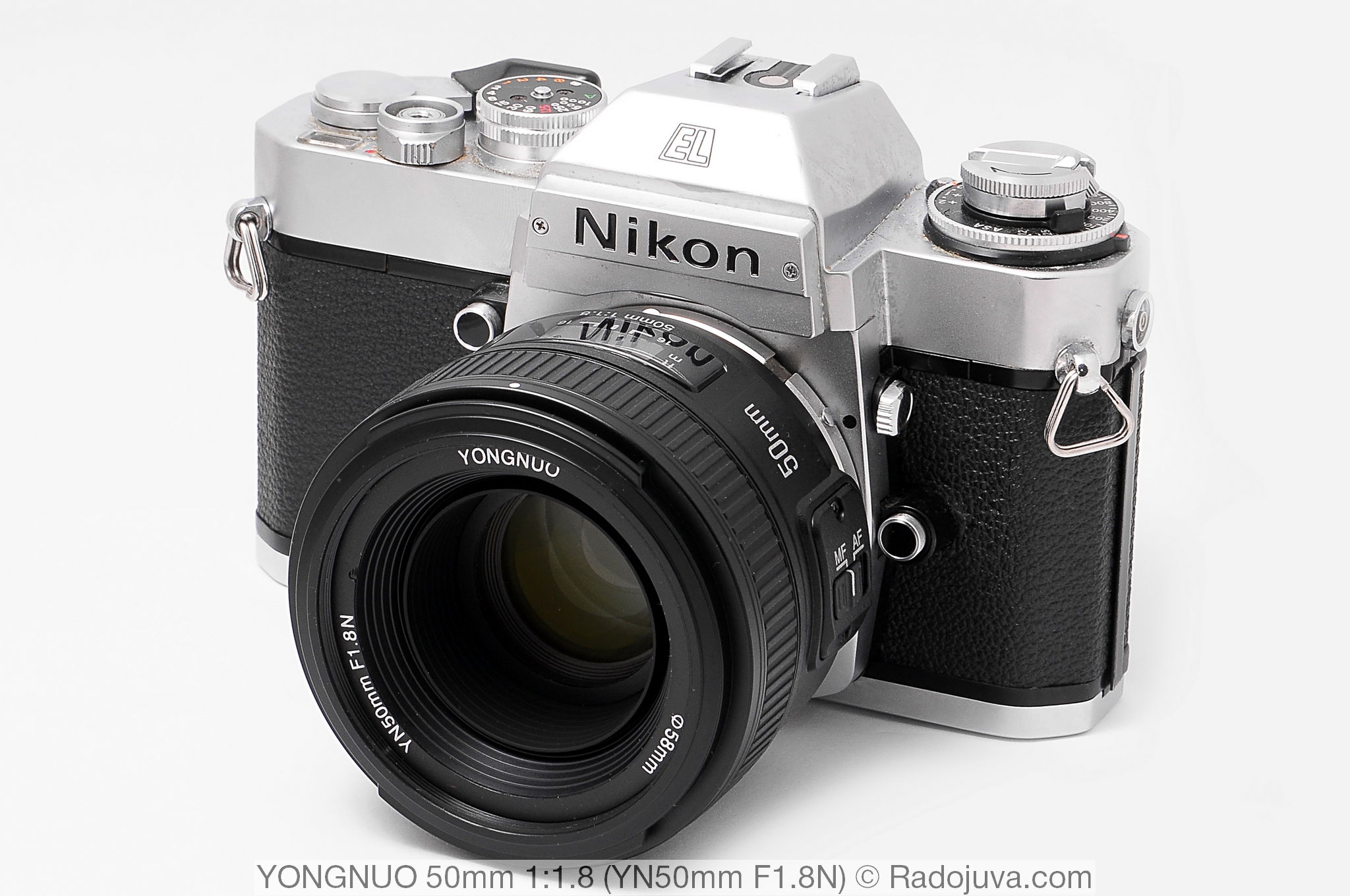
YONGNUO 50mm 1: 1.8 (YN50mm F1.8N). The lens is shown in film slr camera Nikon EL2. Enlarge Image.
Navigation
- Browse Navigation
- In short
- History
- All lenses and teleconverters Yongnuo
- Main Specifications
- Assembly
- Focusing
- Image quality
- Sample photos on Nikon D70
- Sample photos on Nikon D90
- Lens prices
- My experience
- Similar lenses from Nikon
- Differences from Nikon 50 / 1.8G
- Differences from Nikon 50 / 1.8D
- Video review
- Results
- User Comments
- Add your review or question on the lens
It's important: Please note that the models of the Yongnuo YN50mm F1.8 lens, in versions for Nikon and Canon, look very different from each other. Typically, third-party lenses, such as Tokina, Tamron, Sigma, Carl Zeiss, etc., have a very similar housing design for versions for different systems.
In short
Yongnuo 50mm 1: 1.8 (YN50mm F1.8N) - very cheap fast half a ruble from the Chinese manufacturer Yongnuo Digital. The lens copied the original housing design Nikon 50 / 1.8G and optical properties Yongnuo Lens EF 50mm 1: 1.8. In general, he is not bad... First of all, Yongnuo YN50mm F1.8N is interesting to owners motorless Nikon cameras... For those who have a Nikon camera with a built-in focus motor, there is a wonderful and inexpensive Nikon 50 / 1.8D (as well as a million of its subversions).
The creative and practical potential of such a fifty dollars is difficult to overestimate. It is suitable for a wide range of photo tasks. Photo enthusiasts often use it as a portrait lens. Many just want a fast fix, in addition to their whale lens. So, f / 1.8 aperture more than three feet wider aperture of f / 5.6, which is used in 'dark' kit lenses at the long end. In numerical terms, this means that Yongnuo 50mm 1: 1.8 (YN50mm F1.8N) is approximately 10 times brighterthan, for example, whale Nikon 18-55 / 3.5-5.6which uses a maximum relative aperture of only 50: 1 over a 5.6 mm focal length. The calculation of the difference in the relative aperture (count the aperture) is performed elementarily: 5.6 * 5.6: 1.8: 1.8 = 9.679, which is rounded to the value '10'.
History
The first lens from Yongnuo Digital is fifty dollars for Canon EOS cameras - Yongnuo Lens EF 50mm 1: 1.8 (YN50mm F1.8) introduced December 27, 2014.
July 10, 2015 in Shanghai was represented version Yongnuo AF-S 50mm 1: 1.8 (AF-S 50mm 1.8, for Nikon cameras). The lens was labeled 'AF-S' and the depth of field was F / 22. Near the thread for the light filter was the inscription 'YONGNUO AF-S 50mm 1.8', near the depth of field scale was the inscription 'AF-S 50mm 1: 1.8'.
On May 7, 2016, the 'YONGNUO Ø58mm YN50mm F1.8' lens went on sale (without the 'AF-S' lettering, without the 'N' lettering and with the depth of field scale for f / 16). Most likely Yongnuo AF-S 50mm 1: 1.8 was just a prototype, its optical design and type of focusing motor will remain unknown.
Some time later, the letter 'N' was added to the lens name - YONGNUO Ø58mm YN50mm F1.8N... 'N' is short for 'Nikon ', after which the lens took the form shown in this review.
On May 14, 2018, an updated version for Canon cameras was presented - Yongnuo Lens 50mm 1: 1.8 II (model YN50mm F1.8II). After 2 weeks, on May 30, 2018, a faster version for Canon cameras was announced - Yongnuo Lens 50mm 1: 1.4 (model YN50mm F1.4). August 18, 2018 was introduced YONGNUO YN50mm F1.4N E.
All Yongnuo Lenses
Bayonet mount Sony FE [DF, FULL FRAME] и Sony E[DA,APS-C]:
- yongnuo 11 mm 1:1.8 DA DSM WL S [announcement]
- yongnuo 16 mm 1:1.8 DA DSM S [announcement]
- yongnuo 35 mm 1: 2 DF DSM S [review]
- yongnuo 50 mm 1: 1.8 DF DSM S [announce]
- yongnuo 50 mm 1:1.8 DA DSM S [overview]
- yongnuo 85 mm 1: 1.8 DF DSM S [review]
- yongnuo 85 mm 1:1.8 DF DSM S II [announcement]
Bayonet mount Canon RF (mirrorless full frame):
- yongnuo 35 mm 1: 2 DF DSM R [review]
- yongnuo 35 mm 1:2 CR [announcement]
- yongnuo 50 mm 1:1.8 DF DSM R [to be announced]
- yongnuo 85 mm 1:1.8 DF DSM R (two subversions with different names) [review]
Bayonet mount Nikon Z [DF, FULL FRAME + DA,APS-C]::
- yongnuo 11 mm 1:1.8 DA DSM WL Z [announcement]
- yongnuo 35 mm 1:2 DF DSM Z [announcement]
- yongnuo 50 mm 1:1.8 DF DSM Z [announcement]
- yongnuo 50 mm 1:1.8 DA DSM Z [review]
- yongnuo 85 mm 1:1.8 DF DSM Z [announcement]
Bayonet mount fujifilm x [DA,APS-C]:
- yongnuo 11 mm 1:1.8 DA DSM WL X [announcement]
- yongnuo 50 mm 1:1.8 DA DSM X Pro [Announcement]
- yongnuo 50 mm 1:1.8 DA DSM X [announcement + overview]
For the system Micro 4 / 3:
- yongnuo 25 mm 1: 1.7 [review]
- yongnuo 42.5 mm 1: 1.7 [review]
- yongnuo 42.5 mm 1:1.7 II [overview]
- yongnuo 12-35 mm 1:2.8-4 STM ASPH MACRO [announcement]
Bayonet mount Nikon f (mirrored full frame):
- yongnuo 14 mm 1: 2.8 [overview]
- yongnuo 35 mm 1: 2 [overview]
- yongnuo 40 mm 1: 2.8 [overview]
- yongnuo 50 mm 1: 1.8 [review]
- yongnuo 50 mm 1: 1.4 E [overview]
- yongnuo 60 mm 1:2 MACRO MF [overview]
- yongnuo 85 mm 1: 1.8 [overview]
- yongnuo 100 mm 1: 2 [overview]
Bayonet mount Canon EF (mirrored full frame):
- yongnuo 14 mm 1:2.8 [review N]
- yongnuo 35 mm 1: 2 [review]
- yongnuo 35 mm 1: 1.4 [overview]
- yongnuo 35 mm 1: 1.4C DF UWM [announce]
- yongnuo 50 mm 1: 1.8 [overview]
- yongnuo 50 mm 1:1.8 II [overview]
- yongnuo 50 mm 1: 1.4 [overview]
- yongnuo 60 mm 1:2 MACRO MF [review N]
- yongnuo 85 mm 1: 1.8 [review]
- yongnuo 100 mm 1: 2 [overview]
Cameras:
- Yongnuo YN433 (2023, Micro 4/3, 20 MP, 4K)
- Yongnuo YN455 (2021, Micro 4/3, 20 MP, 4K)
- Yongnuo YN450/450M (2019, Micro 4/3 -> Canon EF, 16 MP, 4K)
Lenses and cameras and many other products from Yongnuo can easily be found at Authorized Yongnuo Dealer / Store on Aliexpres.
My video on all Yongnuo lenses here.
Yongnuo Digital lenses replicate the optical design of older Canon EOS lenses. Usually, a version for Canon comes out first, and after a while for Nikon. For other popular SLR systems (Pentax, Sony, Sigma, Micro 4/3), Yongnuo does not produce lenses. And Yongnuo Digital teleconverters exist, at the moment, and at all only for Canon EOS cameras.
Main technical characteristics of YONGNUO 50mm 1: 1.8 (YN50mm F1.8N):
| Review Instance Name | Near the front lens: YONGNUO Ø58mm YN50mm F1.8N. On the case: 50mm 1: 1.8 SN0011346. On the box: YONGNUO DIGITAL YN50mm F1.8N standart prime lens |
| Basic properties |
|
| Front Filter Diameter | 58 mm, plastic thread for filters |
| Focal length | 50 mm, EGF for Nikon DX cameras is 75 mm |
| Zoom ratio | 1 X (this is a fixed lens, it does not have a zoom) |
| Designed by | for full and cropped Nikon digital cameras |
| Number of aperture blades | 7 rounded petals |
| Tags | focusing distance in meters and feet, depth of field for F / 16, mark of bayonet mount and hood mount |
| Diaphragm | from F / 1.8 to F / 16, without aperture ring, lens analog Nikon G. |
| MDF | 0.45 m, maximum magnification ratio 1: 6.7 |
| The weight | 203 g
(since about 2018, the weight of some lenses is 177 grams) |
| Optical design | 6 elements in 5 groups. The lens does not use special optical elements in its optical design.
The optical design is identical to the lens. YONGNUO LENS EF 50mm 1: 1.8. Also, a similar optical scheme is used by lenses:
Optical design like a double lens of Gaus (i.e. this is Planar). |
| Lens hood | Plastic, bayonet type. The model is unknown. It can be supplied. |
| Manufacturer country | The country of manufacture is not indicated on the lens case. But, in fact, the lens is made in China. |
| Period | Available May 7, 2016. Prototype shown July 10, 2015. |
| Instructions | View my scan (English only) |
| Price | View on Aliexpress from a trusted seller |
For some reason, on the network, I met very little information directly about the fifty dollars from Yongnuo for Nikon cameras, because in this review I tried to add as much useful information as possible on the YN50mm F1.8N.
Assembly
The lens came to me for review almost new. Before sending it for review, the owner used it for only a few days.
In a small box is a warranty card, instructions in Chinese and English, and the lens itself with a front (YN-58) and a back cover. The box is made in the colors typical of the golden boxes of Nikon Nikkor lenses. What the copy from this review did not have was a protective film on the front and rear lenses, which originally comes with the lens.
The lens is well assembled. It's nice that, unlike the version Yongnuo Lens EF 50mm 1: 1.8The Yongnuo YN50mm F1.8N version has a metal mount mount. The focus ring is rubberized. It is stated that the contacts of the microcircuits are gold-plated to improve the passage of current.
Of the shortcomings I want to highlight:
- The focus ring has a slight backlash.
- If you press the diaphragm lead (the tab for controlling the diaphragm) from the bayonet side, it will be noticeable that the aperture blades not only close / open but also move back and forth towards the front or rear lens. In other lenses, I did not observe such a looseness of the aperture mechanism. I can’t tell how critical this behavior of the diaphragm mechanism is. During real photography, I did not have any problems with the aperture. True, there are rumors in the network that the diaphragm mechanism is a weak link in this lens.
- Yongnuo YN50mm F1.8N weighs 20 grams heavier than the original Nikon 50 / 1.8G, from which the case design was copied (185 vs 203 grams). However, in my hands I got another new Yongnuo YN50mm F1.8N, made at the end of 2018 and its weight is 177 grams.
- Also, it's a pity that I didn't find a hood in the package. At the same time, some Yongnuo YN50mm F1.8N lenses come with a plastic bayonet type hood. It is not known why not all YN50mm F1.8N lenses are equipped with a hood.
- Several times during high-speed continuous shooting, the camera lost contact with the lens. To restore performance, it was necessary to disconnect the lens and reinstall it on the camera. This situation occurred several times on different cameras, which indicates a problem with the lens, not the camera.
- Unlike Nikon 50 / 1.8GThe Yongnuo YN50mm F1.8N is not dust- and waterproof rubber lens mount seal.
- There is no inscription about the country of manufacture on the lens case. Of course, we all know very well that the lens is made in China, but still the lack of information on the product itself only adds to the alarm.
The diameter of the front filter is 58 mm, the same diameter uses Nikon 50 / 1.8G and many other lenses.
I want to note that the Yongnuo YN50mm F1.8N (for Nikon cameras) is better made than Yongnuo Lens EF 50mm 1: 1.8 (for Canon cameras). Unlike the version for Canon cameras, it uses a metal lens mount, virtually internal focusing, has a window with a focusing distance, the depth of field scale, a more elaborate AF / MF switch and can use a bayonet type hood.
UPDATE 1: With some cameras and some instances of the Yongnuo YN50mm F1.8N, the access to the memory card indicator blinks when turned off. Most likely the camera constantly 'disconnects / connects' the lens. The exact cause is unknown.
UPDATE 2: With some cameras, the battery power decreases when turned off.
Focusing
The lens has built-in focus motor DC-type (DDirectly Current Motor- ordinary DC motor). To be precise, the Yongnuo YN50mm F1.8N is an analog of the Nikon series lenses AF-I. Unlike lenses Nikon AF-Sthat use ultrasonic focusing motors Nikon SWMold lenses Nikon AF-I use a built-in buzzing micro focus motor similar to the Yongnuo DC.
The lens will automatically focus on all Nikon DSLR cameraseven on amateur series models Nikon DXthat do not have a built-in focus motor: D40, D40x, D60, D3000, D3100, D3200, D3300, D3400, D3500, D5000, D5100, D5200, D5300, D5500, D5600as well as mirrorless cameras Nikon Z with adapter FTZ / FTZ II.
When focusing the motor is noisy. Strange, but the noise level is much lower than the lens Yongnuo Lens EF 50mm 1: 1.8. It is very good that the Yongnuo YN50mm F1.8N noise is less than non-motor Nikon 50 / 1.8D. Sorry, but low noise from the ultrasonic motor Nikon 50 / 1.8G he does not compare.
Auto focusing on the lens is enough fast. Auto focus speed comparable to Nikon 50 / 1.8G.
When used on a camera Nikon D90 (with unpretentious Multi-CAM 1000 focusing system), as well as on the camera Nikon D70 (with super-simple Multi-CAM 900 focusing system), the lens behaves well, rarely focuses incorrectly. I had no problems with focus accuracy and focus. I was pleasantly surprised by the quality of the focus. On camera Nikon D90 I checked the presence of the back and focus front at different focusing distances (infinity and MDF as well). Pictures taken using the Live View mode (which does not suffer from back / front focus) were used as a measure. Focusing accuracy using phase sensors completely coincided with the Live View mode.
I have a lot of experience with the lens Nikon 50 / 1.8D. I want to note that, nevertheless, the Yongnuo YN50mm F1.8N focuses in the general case not as confidently as the original lens.
When focusing, the front lens group moves in the middle of the frame of the housing. I can’t say that the lens has internal focus. But when focusing the lens does not change its size, and the filter is wound on a fixed outer part of the frame of the housing. This type of focusing can also be found in Nikon 50 / 1.8G и Nikon 50 / 1.4G.
The focus ring is rubberized and rotates approximately 80 degrees. When extreme positions are reached, the ring abuts. The focus distance scale rotates in the opposite direction to the rotation of the focus ring (I see this for the first time!). Manual aiming is not very convenient. During manual focusing, you can hear 'plastic rubbing against plastic'.
The lens barrel has an 'AF / MF' (auto focus / manual focus) focus mode switch. During autofocus, the focus ring remains stationary and can be freely rotated 360 degrees without affecting focus.
The lens has a window with a focus distance scale in meters and feet, as well as a depth of field scale for F / 16. The minimum focusing distance is 45 cm, and the maximum magnification ratio is 1: 6.7 (typical for similar fifty dollars).
Other features:
- Yongnuo YN50mm F1.8N has no focus problems in Live View (tested on Nikon D90).
- The lens transmits the focus distance to the subject in the camera (analog Nikon D, Nikon G).
- Yongnuo YN50mm F1.8N has a slightly pronounced 'Focus Breathing' effect (changing the viewing angle during focusing). During focusing towards the MDF, the viewing angle decreases.
- The viewing angle of the Yongnuo YN50mm F1.8N is slightly wider than that of Nikon 50 / 1.8D. It may seem that the focal length of the Yongnuo YN50mm F1.8N is closer to 45 mm.
- Focusing is performed by simultaneously moving the entire lens block (all lenses) relative to the focal plane.
- Yongnuo YN50mm F1.8N does not have a hard stop (hard infinity mechanical stop) which allows you to accurately and quickly focus the lens at infinity under any external temperature conditions. For accurate aiming at infinity, you cannot just bring the focus ring to its extreme position.
- Important: YN50mm F1.8N has a small focus-shift (shift-focus). During aperture, the exact focus moves away from the lens. The level of shift is the same as that of Nikon 50 / 1.8D.
- Important: Yongnuo YN50mm F1.8N is a third-party lens. It may happen that it will not work correctly with the new Nikon cameras, which will be presented after the announcement of this lens. Details on this issue are considered by me. here.
- Important: I have already met on the net that the Yongnuo YN50mm F1.8N does not automatically focus with some Nikon cameras. And also I met information that the Yongnuo YN50mm F1.8N may suffer from a strong twitching of focus. Obvious problems are observed with the model Nikon D300s.
- Important: this instance suffers from front focus on the camera Nikon D40, which is used by the owner of this lens (according to the owner).
- Unknown compatibility with teleconverters.
- Unknown compatibility with adapter FT-1 for Nikon 1 system cameras.
To summarize, then the lens is focused with focusand the clever design of the housing and 'AF / MF' switch make the YN50mm F1.8N more convenient to use than Nikon 50 / 1.8D.
Image quality
The color rendering is pleasant, in some ways even better than the original Nikon 50 / 1.8D. Also, I want to note that enlightenment in versions Yongnuo Lens EF 50mm 1: 1.8 and Yongnuo 50mm 1: 1.8 (YN50mm F1.8N) visually very different. Most likely the version for Nikon uses updated enlightenment.
Chromatic aberration was not without. Friging (green and purple contours of contrasting objects in the blur zone, example).
In the center of the frame, the lens is sharp enough already at F / 1.8. Confident sharpness in the center of the frame comes with F / 2.2-F / 2.5. At f / 2.8 aperture, the lens in the center of the frame is very good. On full-format cameras, there will most likely be a noticeable subsidence of sharpness at the corners and edges of the image.
The vignetting level on APS-C cameras is low even at F / 1.8. I did not have a 58 mm filter on hand to check how much it could affect vignetting.
The level of distortion is small.
The lens well tolerates back and side light. The deep-set front lens contributes to this. The frame of the case works like a small hood. In rare cases, you can get a slight rainbow stratification of the rays and small glare. With an optional bayonet hood installed, backlit and side-light operation should improve. From bright objects to achieve the effect of a 14-ray star pretty hard. Due to the rounded petals, the effect occurs only on strongly covered diaphragms (example), while the formed star is not very beautiful and poorly expressed.
I want to separately highlight in bold, which is optically YN50mm F1.8N no worse than the original Nikon 50 / 1.8D. Laboratory tests may even show the superiority of the YN50mm F1.8N. True, modern Nikon cameras can automatically correct some flaws. Nikon 50 / 1.8Dsuch as vignetting, distortion, chromatic aberration etc., in the case of the YN50mm F1.8N, third-party software (or not) must be used to remove distortion.
On open apertures, the bokeh of the lens is no different Nikon 50 / 1.8D и Canon 50 / 1.8 II. The reason for this the same similar optical design. Below is a GIF animation of the optical circuit for six of these lenses:
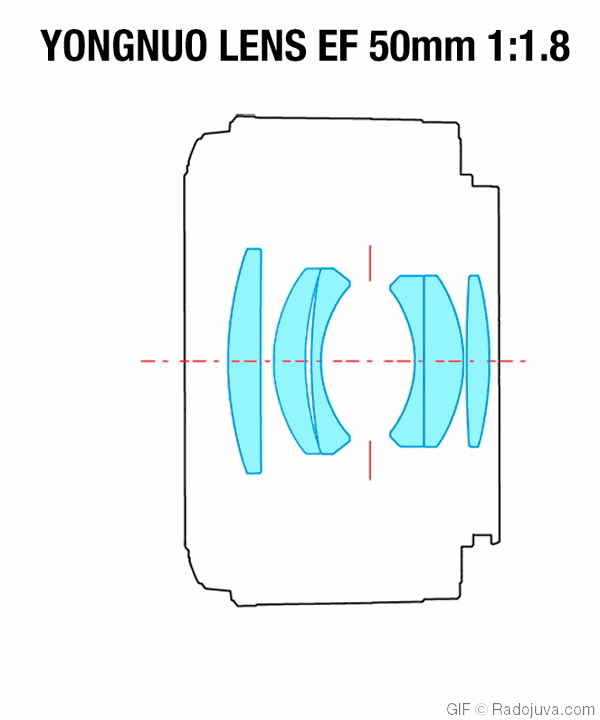
Optical schemes of lenses: YONGNUO LENS EF 50mm 1: 1.8, Yongnuo YN50mm F1.8N (from review), Canon Lens EF 50mm 1: 1.8, Canon Lens EF 50mm 1: 1.8 II, Canon Lens EF 50mm 1: 18 STM, Nikon 50mm 1: 1.8D AF Nikkor
Sample photos on Nikon D70
Pictures from Nikon D70. Photos are shown without processing, on-camera JPEG. You can see the bokeh of the lens.
You can download the source files at this link (56 JPEG files).
Sample photos on Nikon D90
Pictures from Nikon D90. The photos in the gallery are shown without processing, the conversion of the source RAW files by the original Nikon ViewNX-i utility without any additional adjustments.
You can download the source files at this link (70 RAW files).
Sample photos in processing
Several photos in processing can be viewed at 500px: 1, 2, etc.
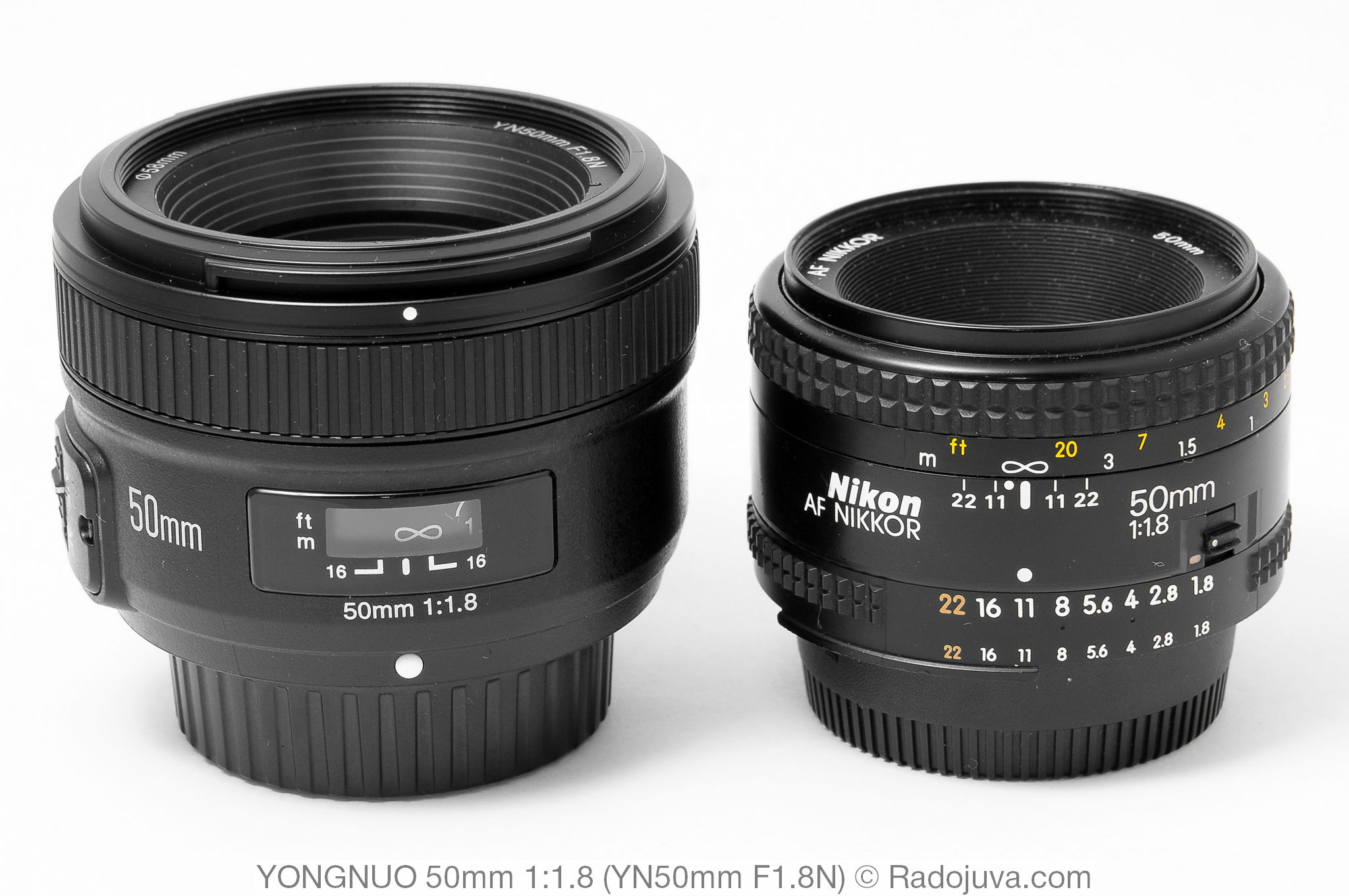
The sizes of the lenses are Yongnuo 50mm 1: 1.8 (YN50mm F1.8N) and Nikon AF Nikkor 50mm 1: 1.8 (MKII, NJ, NIKON JAPAN version)
Prices
Prices for Yongnuo 50mm 1: 1.8 lens (YN50mm F1.8N) at aliexpress.com can see and buy at this link. On aliexpress.com this lens is sold at the cheapest prices. In all other places, for example, in local stores of the former CIS countries, Yongnuo 50mm 1: 1.8 is much more expensive.
Comments on this post do not require registration. Anyone can leave a comment. Many different photographic equipment can be found on AliExpress.
My experience
A cheap fifty for Nikon non-motorized cameras is very good. Motorized camera owners could always afford to buy a pretty one Nikon 50 / 1.8D for only 90-110 dollars. But for owners of non-motorized cameras had to buy a more expensive Nikon 50 / 1.8G (170-200 dollars). With the advent of Yongnuo 50mm 1: 1.8, you can afford a brand new fifty dollars with an integrated focus motor for $ 80.
I relate to the YN50mm F1.8N quite warmly and am glad that amateurs have the opportunity to cheaply buy a high-aperture fifty. I'm also glad that the YN50mm F1.8N turned out to be better overall than Yongnuo Lens EF 50mm 1: 1.8. It’s only a pity that the Nikon version costs half the price of the Canon version.
Important: This lens is primarily intended for amateur photographers (not professionals or advanced amateurs!) who will be careful about their photo equipment and not use it in conditions with a heavy load (weddings, reports, extreme conditions, etc.). I saw with my own eyes how my colleague, during a lens change, dropped Nikon 50 / 1.8D from a meter height onto a concrete floor. The lens received only a tiny scratch on the body, but this did not affect its functionality. I don't think the Yongnuo 50mm 1: 1.8 will stand up to this test.
Of course, the stress resistance of Yongnuo 50mm 1: 1.8 is not comparable to the old manual lenses Nippon Kogaku Japan Nikkor-S Auto 1: 2 f = 5cm or Nikon Nikkor-SC Auto 1: 1.4 f = 50mm, or MS Helios-81H 2/50... However, for most tasks, I would have preferred the presence of autofocus in front of a sturdy, quality body. Users who are looking towards the YN50mm F1.8N are often strapped for funds and faced with a choice: 'This Chinese' or 'Japanese manual'? In personal messages I am very often asked this question. Usually I give the answer that for photography in general it is better to "Chinese", and for video shooting (where automatic focus is not so important) - any "Japanese manual".
If to summarize completely all my experience with the lens, here is my brief recommendation: YN50mm F1.8N can be safely bought for Nikon non-motorized cameras (exact list here) For cameras with built-in focus motor (exact list here) it is better to take the original Nikon 50 / 1.8D (does not matter, used or new).
All Nikon 50 / 1.8 Autofocus Lenses
- Nikon 50mm 1: 1.8 AF Nikkor (first version, MKI) - the lens was produced only in Japan from 1986 to 1990. It is easy to distinguish by a window with a focusing distance and a narrow plastic focus ring. There are two subversions that are no different:
- MKI first subversion. Weighing 210 grams. It is easy to distinguish by the screw under the inscription '1: 1.8'. From September 1986 to March 1987. Serial numbers start at 2
- MKI second version. Weighing 165 grams. It is easy to distinguish by the absence of a screw under the inscription '1: 1.8'. From 1987 to 1990. Serial numbers start at 3.
- Nikon 50mm 1: 1.8 AF Nikkor (second version, MKII, also known as the 'N', or the 'NEW' version) - the lens was produced in Japan and China. The MK II version was produced from 1990 to 2001. There are three subversions that are no different:
- Nikon 50mm 1: 1.8D AF Nikkor (third version, MKIIIbetter known as 'D'-version) - the lens is available from 2002 to this day. All lenses are made in China.
- Nikon AF-S Nikkor 50mm 1: 1.8G SWM Aspherical (fourth version, MKIVbetter known as '1.8 G'-version or '1.8 AF-S' version) - the lens has been produced since 2011, all lenses are made in China.
- Nikon AF-S Nikkor 50mm 1: 1.8G SWM Aspherical Special Edition (fifth version, MKVbetter known as version 'Special Edition' or 'SE' or version for the camera with a retro design of the case Nikon Df) - the lens has been available since the fall of 2013. All lenses are made in China.
- Nikon Nikkor Z 50mm 1: 1.8 S, from summer 2018, lens for mirrorless cameras with Nikon Z mount... Diagram of 12 elements in 9 groups, 2 ED, 2 ASP.
Details on the lineup of fifty dollars from Nikon can be found in my article 'All Nikon autofocus fifty dollars'.
I want to note that the MKI, MKII, MKII versions use the same 6/5 optical circuitry, similar to the YN50mm F1.8N.
Versions MKIV, MKV use the updated optical scheme 7/6.
Differences from Nikon 50 / 1.8G
The main differences between Yongnuo 50mm 1: 1.8 (YN50mm F1.8N) and Nikon AF-S Nikkor 50mm 1: 1.8G SWM Aspherical:
- YN50mm F1.8N is a newer lens introduced 5 years after the release Nikon 50 / 1.8G.
- YN50mm F1.8N is 18 grams heavier Nikon 50 / 1.8G. The YN50mm F1.8N does not come with an integrated hood.
- У Nikon 50 / 1.8G Yes rubber lens mount sealwhich makes the mount mounts dustproof and waterproof.
- Lenses use different focus motors. YN50mm F1.8N uses a conventional micro motor, Nikon 50 / 1.8G uses a Nikon SWM ultrasonic motor. The focusing speed is practically the same.
- Nikon 50 / 1.8G has the ability to constantly manually control the focusM / A'. For manual focusing, YN50mm F1.8N must be set to the 'MF' position.
- Different optical schemes. Nikon 50 / 1.8G uses a more modern optical scheme, including one aspherical element, which allows to achieve better image, especially on open diaphragms.
- Modern Nikon cameras can automatically correct some lens distortion Nikon 50 / 1.8G. With the YN50mm F1.8N, some image enhancement functions will not be available, since this lens is not in the memory of modern cameras.
- Cost of new Nikon 50 / 1.8G about 2-3 times the cost of the new YN50mm F1.8N.
Differences from Nikon 50 / 1.8D
The main differences between Yongnuo 50mm 1: 1.8 (YN50mm F1.8N) and Nikon 50mm 1: 1.8D AF Nikkor:
- YN50mm F1.8N is a newer lens introduced 14 years after the release Nikon 50 / 1.8D.
- Lenses use a completely different body design. Visually Nikon 50 / 1.8D much smaller YN50mm F1.8N.
- Nikon 50 / 1.8D about 50 grams lighter than the YN50mm F1.8N.
- The YN50mm F1.8N uses a built-in micro focus motor to focus. Nikon 50 / 1.8D It does not have a built-in focus motor and focuses due to the focus motor built into the camera. This is one of the main functional differences between the lenses.
- Unlike Nikon 50 / 1.8D, during focusing, the YN50mm F1.8N does not have a barrel extension.
- Modern Nikon cameras can automatically correct some lens distortion Nikon 50 / 1.8D. With the YN50mm F1.8N, some image enhancement functions will not be available, since this lens is not in the memory of modern cameras.
- Nikon 50 / 1.8D It has an aperture control ring that the YN50mm F1.8N does not have.
- New Nikon 50 / 1.8D It costs a bit more than the new YN50mm F1.8N.
To summarize, it turns out that the Yongnuo 50mm 1: 1.8 mixture Nikon 50 / 1.8D и Nikon 50 / 1.8G. From Nikon 50 / 1.8G he took control and body design, and from Nikon 50 / 1.8D took the optical circuit. Functionally, Yongnuo 50mm 1: 1.8 is still closer to Nikon 50 / 1.8G.
Video review
A brief video review can be viewed on my Youtube channeleither here:
Results
Yongnuo 50mm 1:1.8 (YN50mm F1.8N) – cheap analog Nikon 50 / 1.8G (only about 100 dollars from this link) is optically close to Nikon 50 / 1.8D. No matter how strange it sounds, the YN50mm F1.8N is a perfectly suitable lens. Given the price / performance ratio, I recommend it to all amateur photographers who want to join the world of fast auto focus lenses.
UPDATE: review appeared Yongnuo 35mm 1: 2 (model YN35mm F2N).
Material prepared Arkady Shapoval. Training/Consultations | Youtube | Facebook | Instagram | Twitter | Telegram

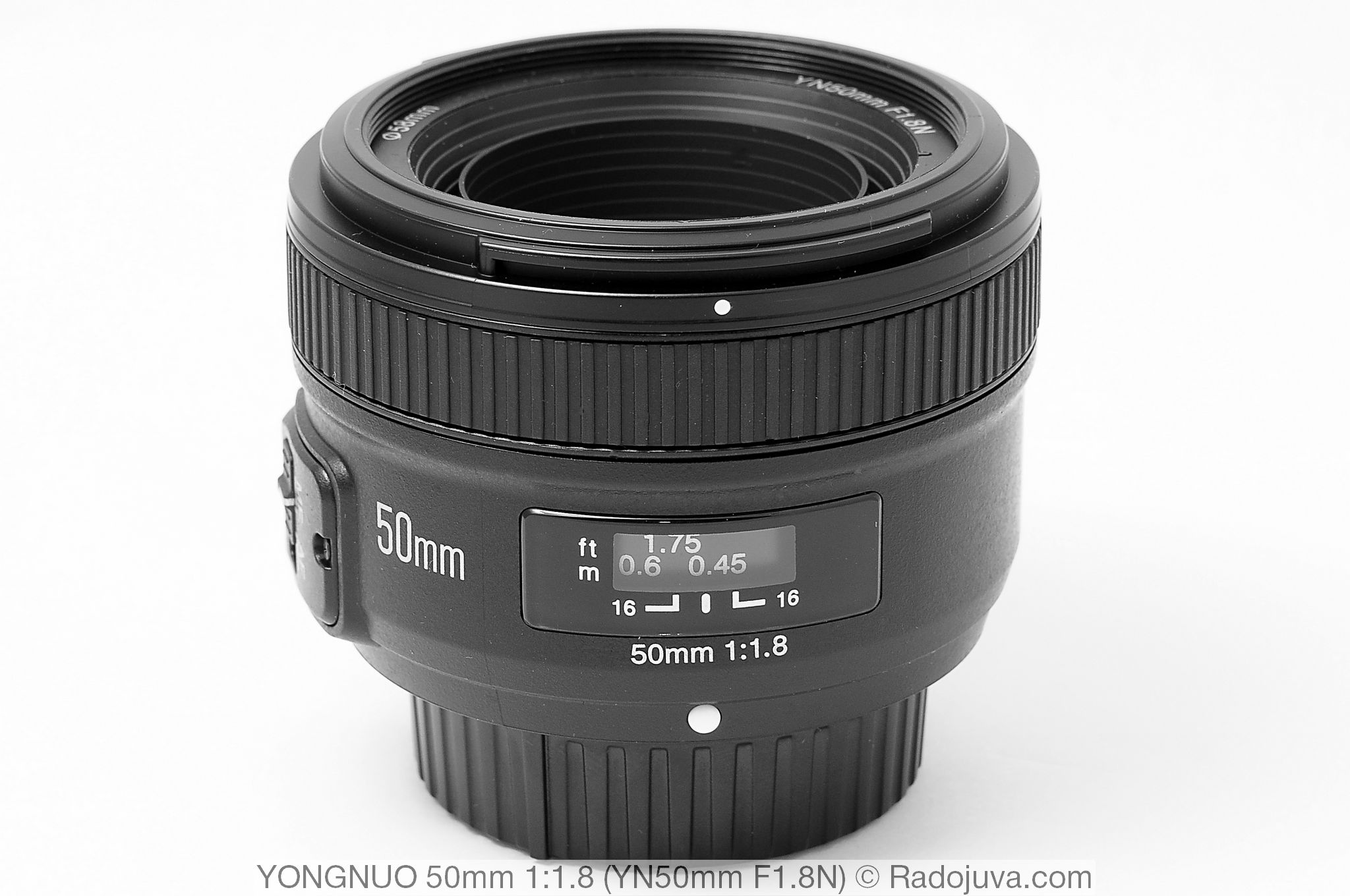
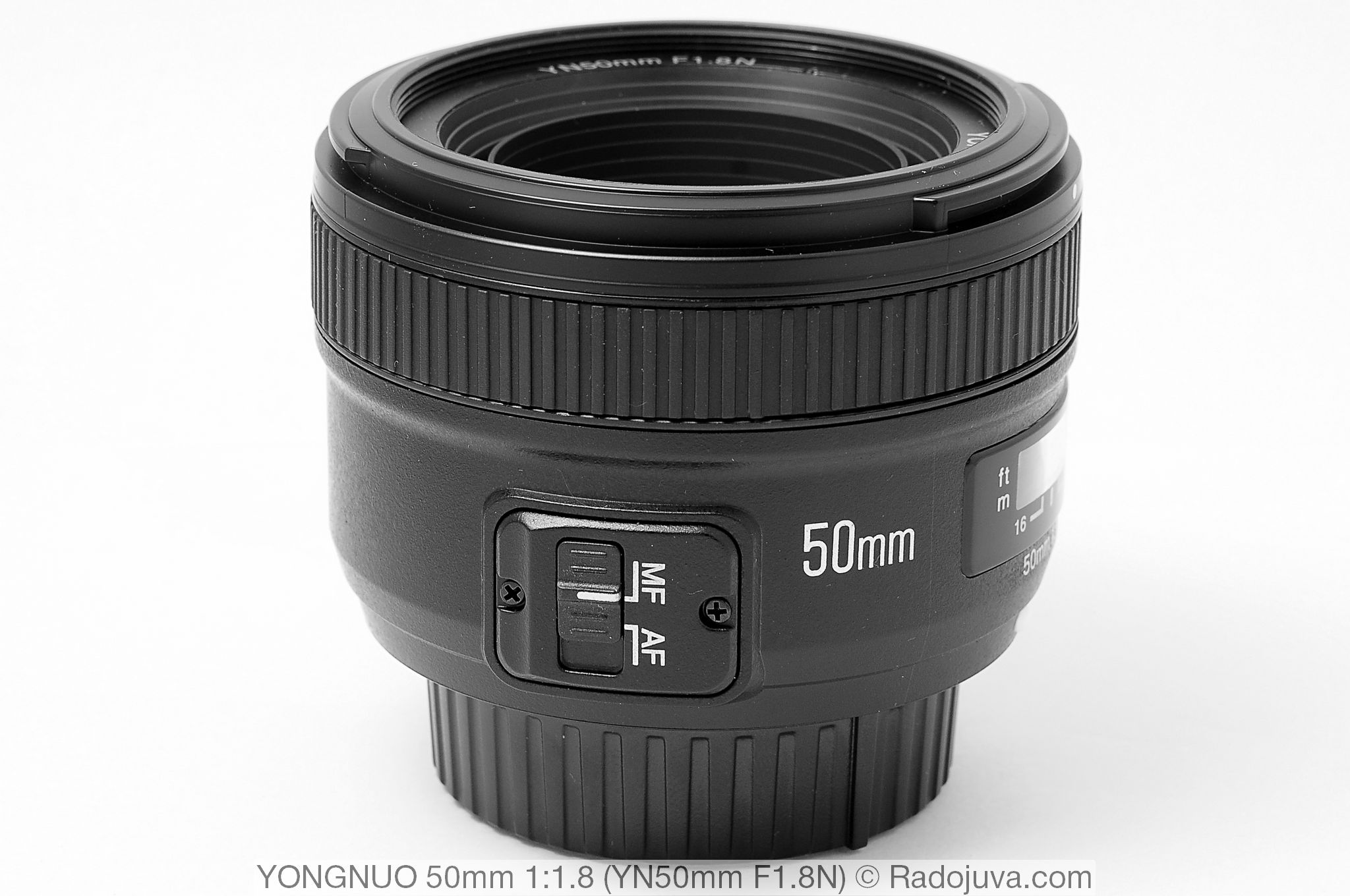
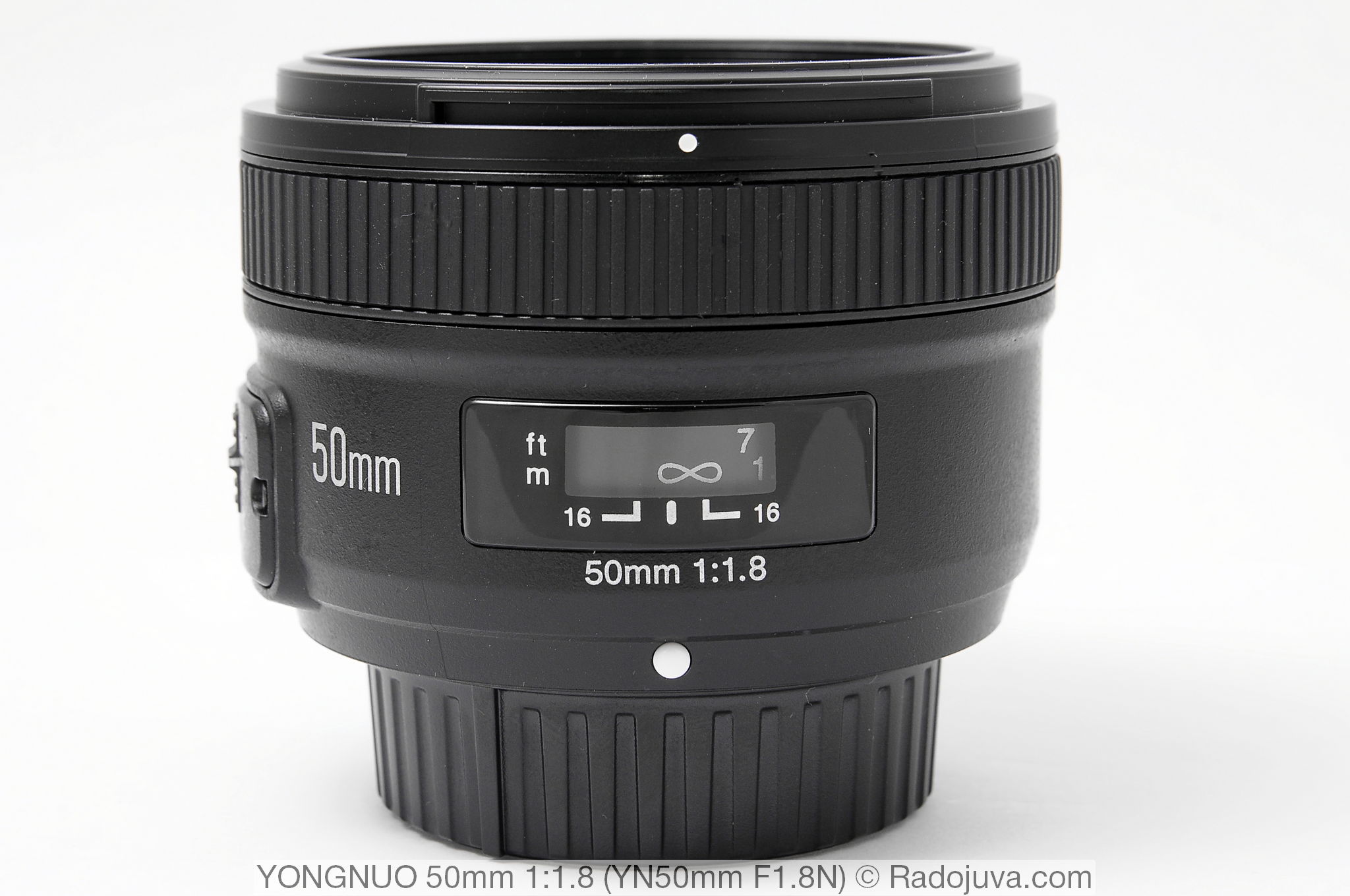
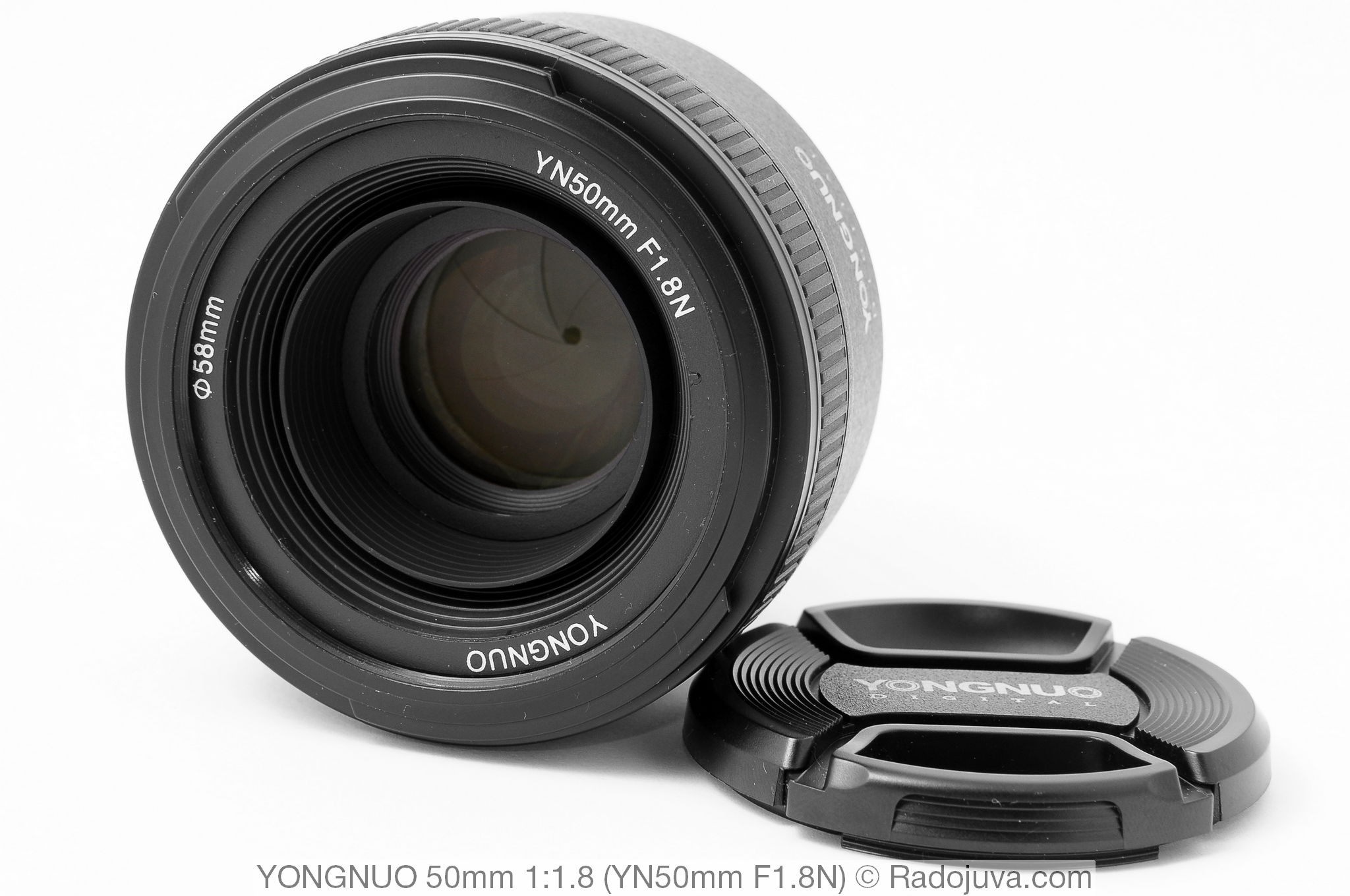
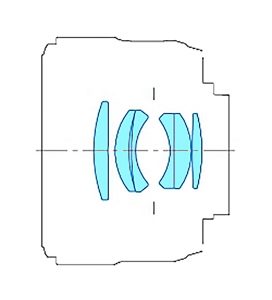
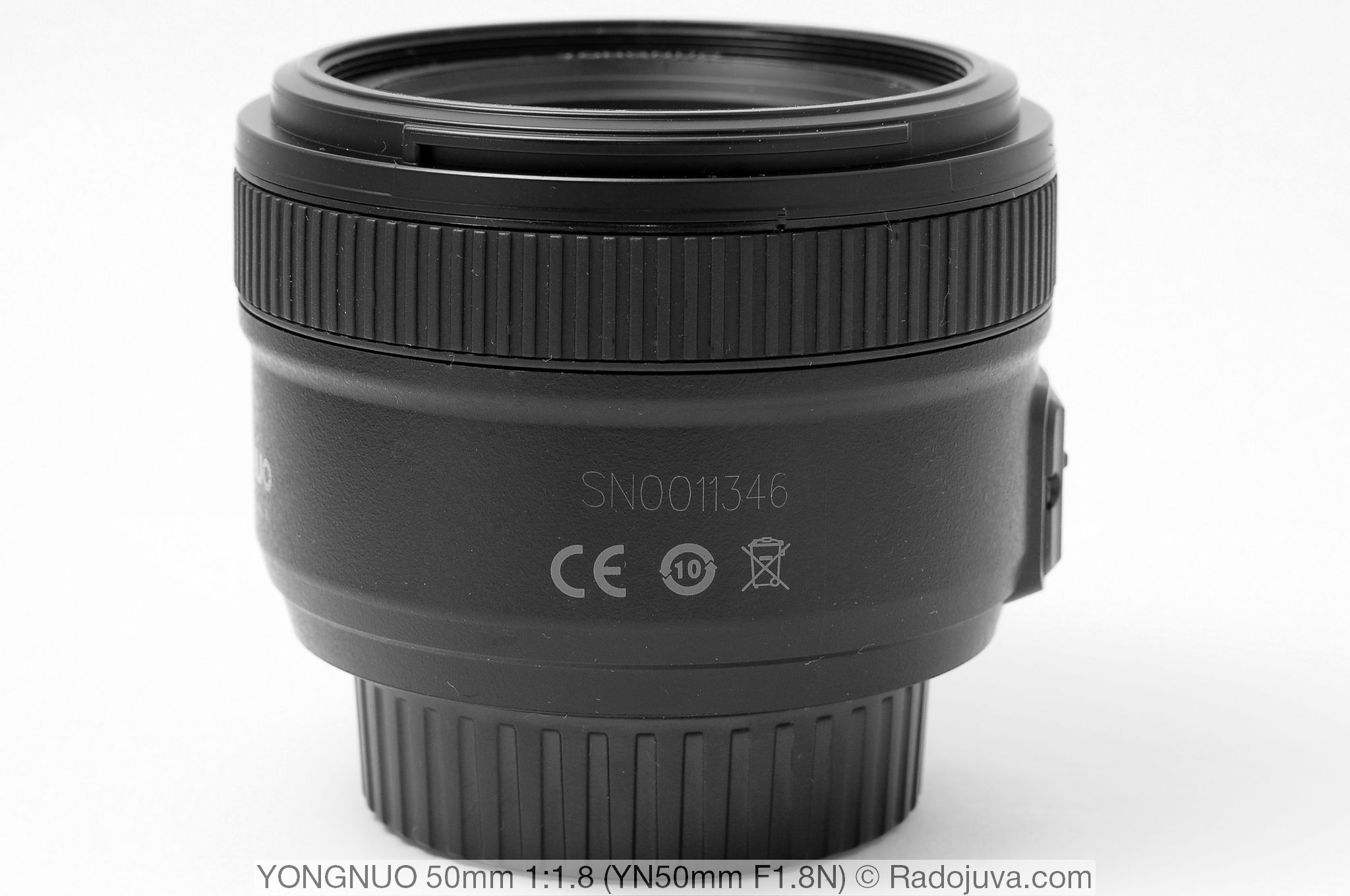
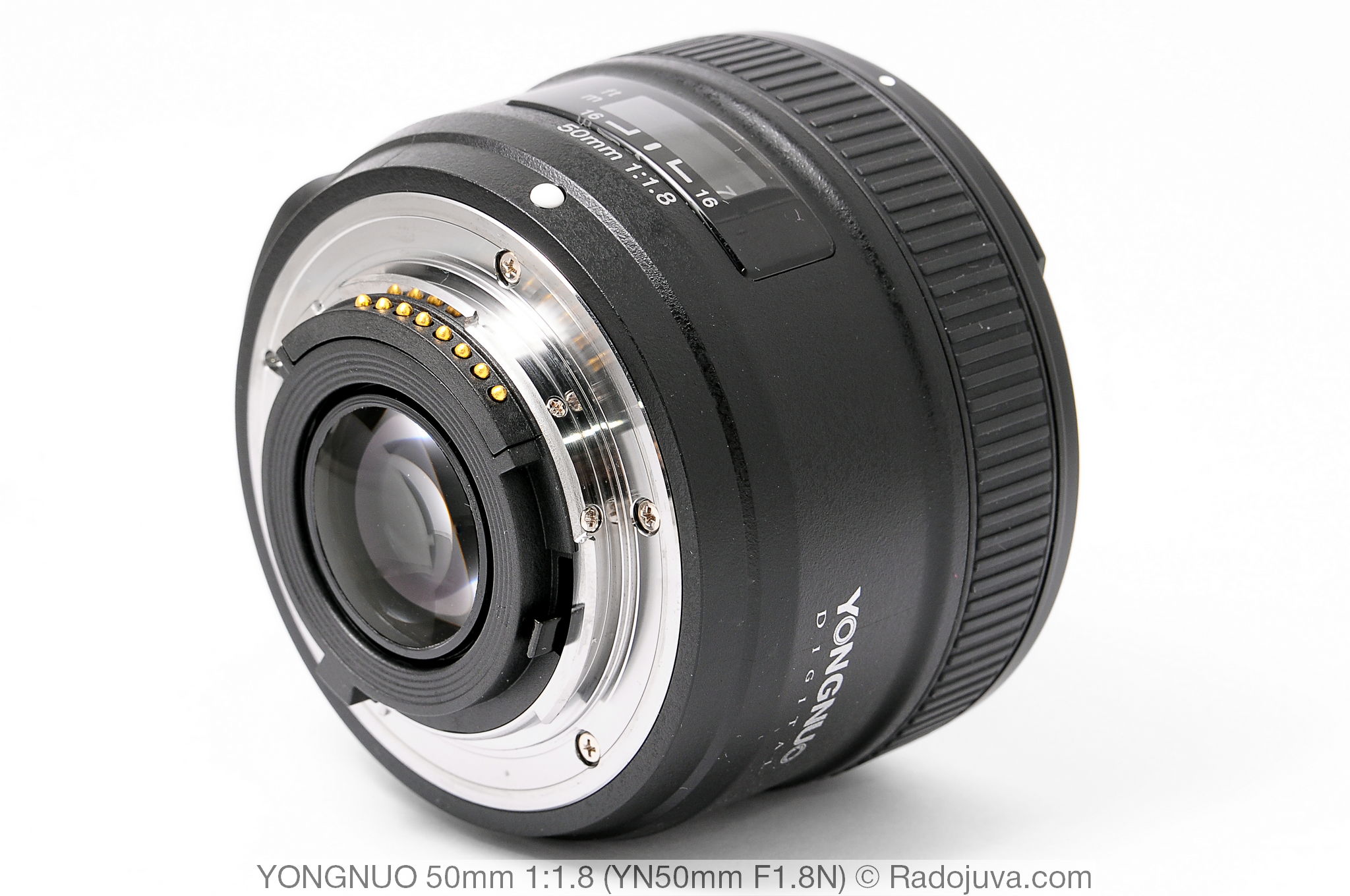
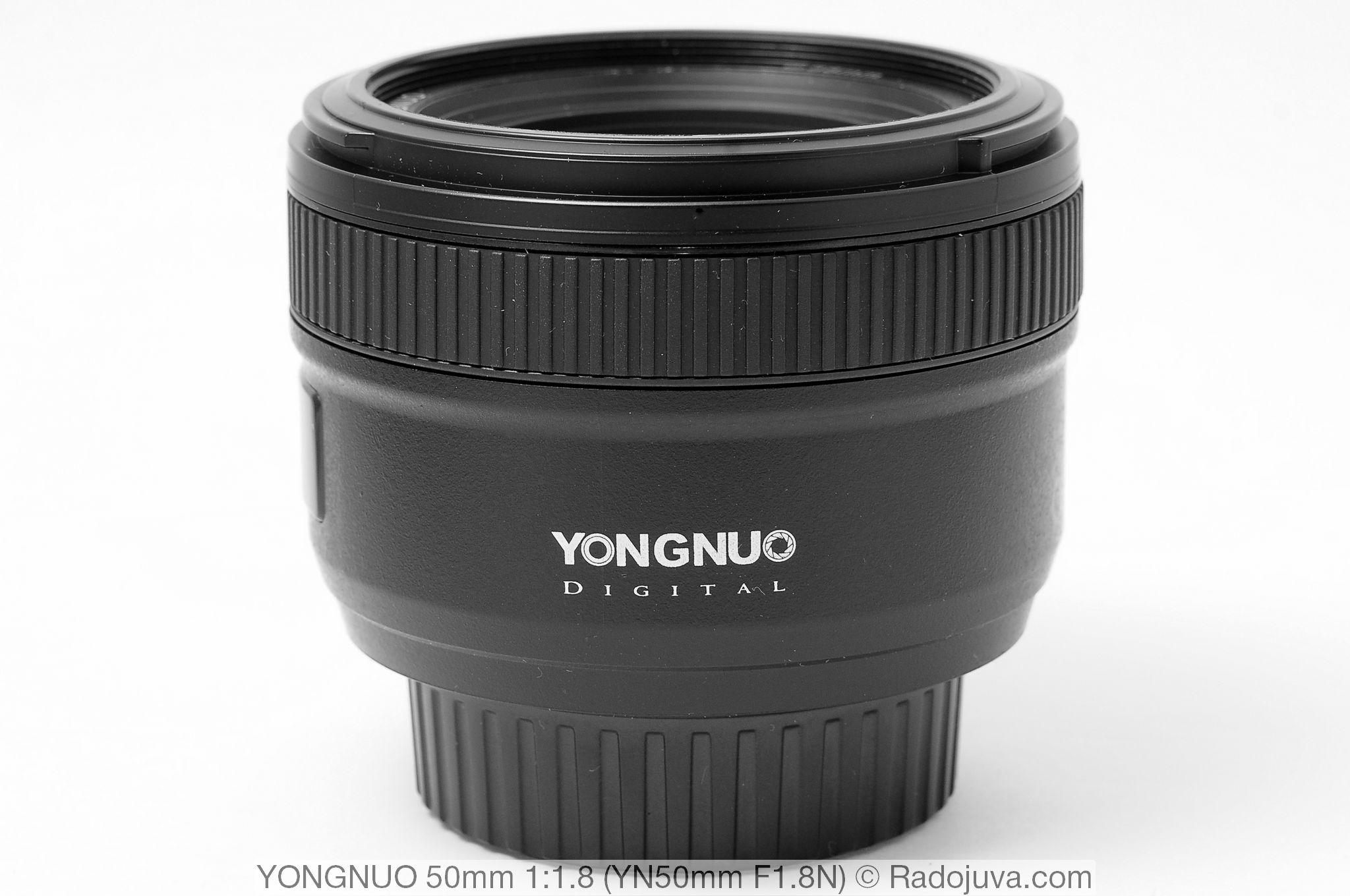











































































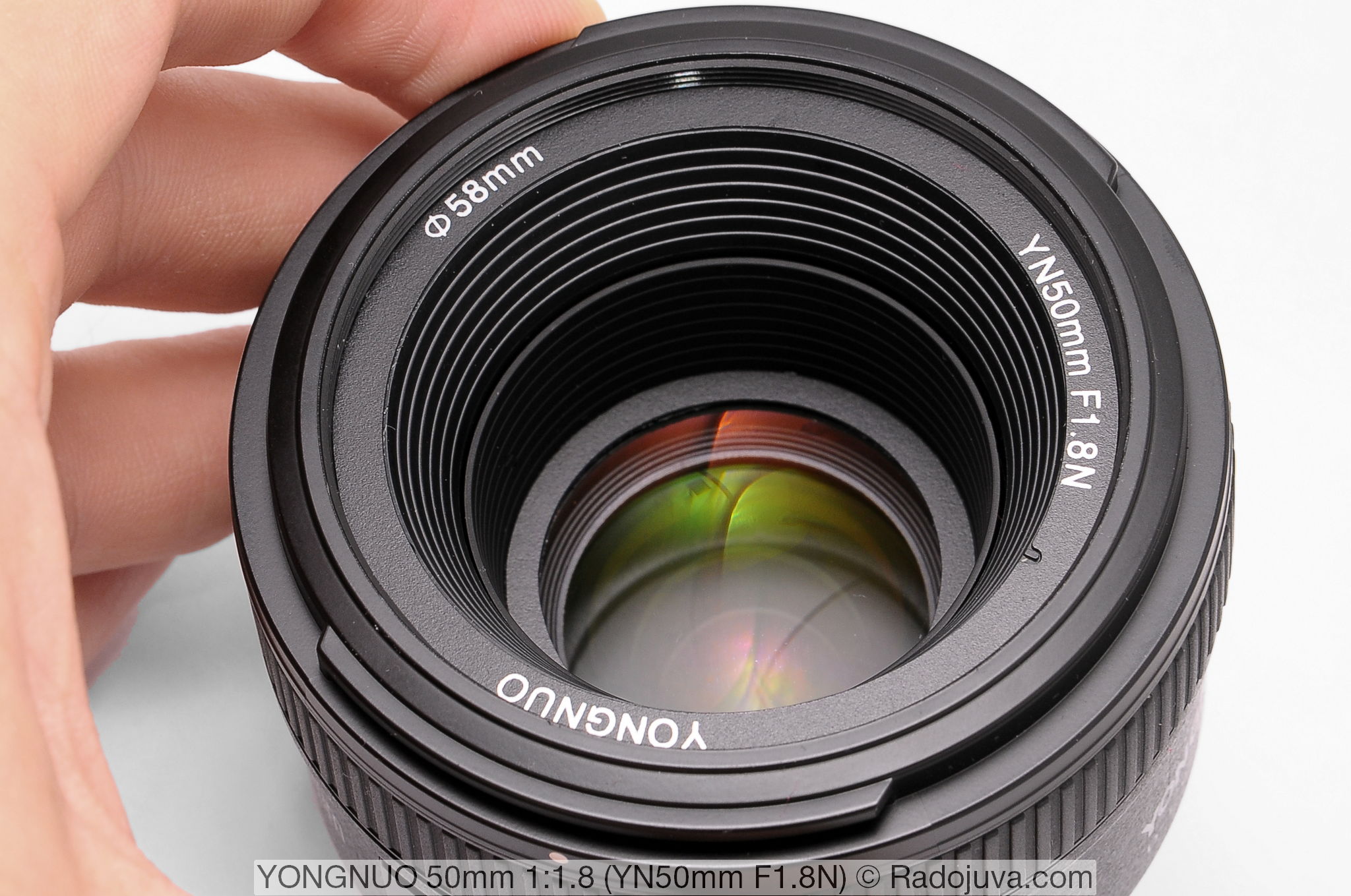
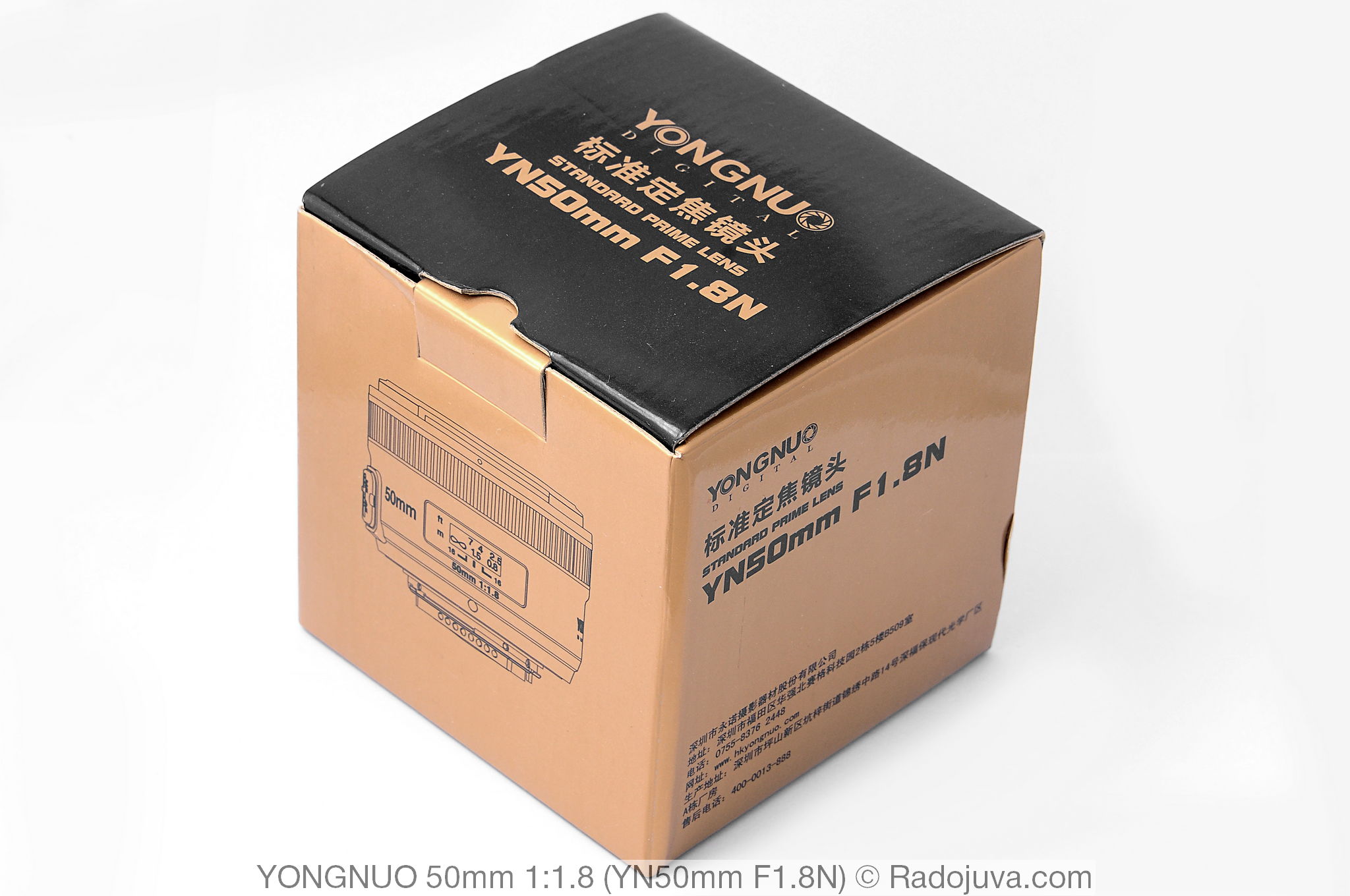
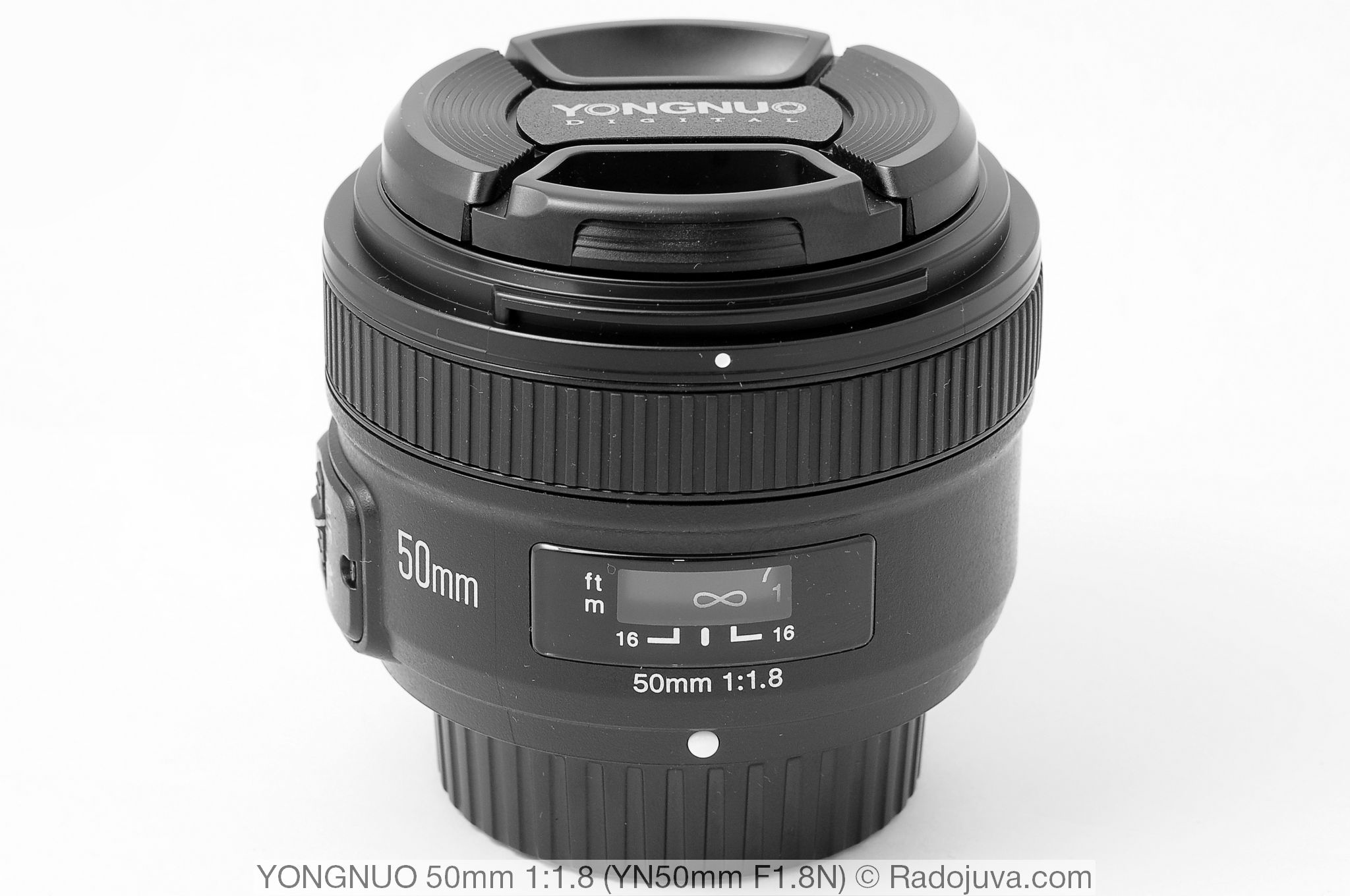

They wrote about incompatibility with the D3200 in the comments. True?
So something became known about compatibility with the D3200?
On my D3200 it works almost without problems (sometimes, as indicated in the article, the connection between the camera and the lens is lost)
I received this device from Ebay today, the lens is really good. Carcass D3400. The sharpness compared to the whale 18-105 is similar even with aperture of 2.8.
1.8 is also good, especially if you take a series of 3-4 shots and choose the sharpest one. Beck and the front focus is not. Bokeh is just gorgeous.
Took for 62 bucks.
Good afternoon!
I am considering a lens for portraiture.
I bought nikon 3400 from 18-105
Read reviews on Nikon 50 / 1.8G, but yongnuo is half the price
Is it worth taking in addition to 18-105?
Rather, it is worth taking in order to feel what a fast fix is. The differences between the original and YN are described here, they must decide for themselves.
If you are interested in playing with bokeh, take it. Plus, the aperture is greater, at aperture 2.2 (optimal in sharpness and bokeh), about 8 times more (18-105 at 50mm aperture 5.0), although there is no stabilizer, therefore, the shutter speed must be set 2 times shorter.
Exactly the same set for half a year. Until spring I used both alternately, now the whale zoom is gathering dust on the shelf. The pictures are much more interesting than the whale and the focal length is suitable for portraits and as a universal one. Only the lens is afraid of light exposure - a hood is required.
Vladimir, do not give the link?
How much did shipping from ebay to Ukraine cost?
Does it make sense to purchase this lens with a nikkor 35km 1.8g dx? I understand that the answer is most likely “for an amateur / you decide”, but I am not an experienced photographer, the opinion of reputable colleagues is required.
Goals, tasks, from which camera and for what situations - to the studio.
Basically, to shoot a one-year-old child and wife, I really want to bring good shots from the sea in the summer. Nikon 3100 camera.
I’ll tell you about my experience: 50mm on cameras like yours for portraits are slightly better than 35mm. This is especially true for close-ups, where 35 can already produce noticeable distortion. Naturally, 50mm will be a little better to blur the background. But it’s just hard to say how much you will need all this.
If you have standard zoom, try shooting a portrait at 35mm and at 50mm. The conclusions will be as follows: you see a fundamental difference and think that 50 mm is better suited for shooting - there is a sense to buy a fast 50 mm fix. If you do not consider the difference between 35 mm and 50 mm as something significant for yourself, then it probably makes no sense to buy.
Summer, sea, landscapes, people. Definitely 35 / 1.8 (there are also 35 and 50mm on the crop) if it is a portrait, then 50mm is better
In summer, at sea, you need a regular VR telephoto zoom. There is the sun, why do you need a fix?
With a fix, you will follow the child all over the beach to and fro, and still nothing really comes of it - while you board, miss the moment.
This is like the basics of reporting shooting))
And my advice to you. Buy an old and cheap machine for the beach, like the D40. And then either they will soprut, or they will trample it, or they will drop it into the water. And the picture will be the same.
As for the zoom, you're right! I was running around the beach with my 35th! But a couple of good shots were successful ... from 1600 =)))
But the camera was never lost)
I got myself this miracle on the D-3100. Very satisfied. The quality of the picture is very sharp. I bought in China on Ali. So take it, you won’t regret it.
I bought this lens for D3300. Everything works fine (diaphragm, autofocus motor), but frankly lathers the whole photo. Sharpness compared to the whale 18-55 is simply none, it is not noticeable on the screen of the camera, but on a computer, when you unfold a photo to the entire monitor, and this is only a quarter of the actual size of the photo, it is soapy soap, as if from the strength of a 1 - 2 Mp camera. I don’t know if it’s worth the paid 4300 rubles, but the quality of the resulting photos leaves me wanting to buy later the original Nikon's fix, except that 85 mm at once, albeit for 30000 rubles, but really high quality.
Perhaps I was just unlucky with the copy, but if you are going to buy it, be prepared to be disappointed.
Now they will again assure that these are excellent lenses ... This is China, and the quality is worse than that of Soviet lenses.
I have a suspicion that, among other things, they eliminate all sorts of glitches and miscalculations after the start of mass production. Those. the later the lens is made, the better it will work.
However, all manufacturers quietly fix problems and do not tell anyone. It's just that Yaga is not shy.
Attach a link to the picture. Everyone understands soap differently. I had YN 50 / 1,8 - in terms of sharpness, I would not say that he was especially inferior to the originals. And it would be good to know what might actually get caught. It's just that there are thousands of sales on Ali, and in the reviews there are not so many complaints about the quality of the picture. By the way, why not open a dispute right away if the lens, in your opinion, is defective? They would return the money - in whole or in part.
maybe he soaps with 24MP?
With 24MP it works fine. We never saw the soap shot. If you want the best quality, take the Nikkor 50mm 1,8G from the available ones.
The lens is afraid of backlight and side light in low light (lens hood to help), otherwise an excellent price / quality ratio. Magnificent portraits with aperture 2.5-2.8 with focusing on the eyes, fast focusing. I use 90% in aperture priority mode. Mileage about 1000 photos, of which up to hundreds in the collection.
The regular 18-105 remains versatile for travel ...
You have hit the mark. if you want quality - take the original.
I purchased a 50 mm-YONGNUO YN F / 1.8 AF for 29.99 USD on ebay. For such money, a very good option.
Link
Why are you advertising scammers?
And here a man sells for $ 60
https://besplatka.ua/obyavlenie/obektiv-yongnuo-yn-50mm-f-1-8-dlya-nikon-analog-nikon-50-1-8g-5093f5
Has gained!!! $ 75 ... (aliexpress)
Satisfied! The picture pleases! After 18-105, there is no sense of versatility ... but that's something special!
Sho then Yes - then Yes!
Powered by D90 ... nothing upset yet!
Got even more than expected)))
All smart photos!
good overview. I would recommend friends but no one ... (from friends, only me and a friend have a DSLR. but a friend is not interested in this. It's easy for him to click and that's it))
Thanks so much for the review. In general, you spent a day following your articles, sorted out some issues that were previously vague for me.
I read from reviews that this lens is green in the photo. What do you say about this?
I am an amateur, a year ago I took the N D3100 with a whale lens and after a digital camera I really like this one) even though I have to shoot only in daylight) I really want to try light-sensitive lenses and I think I'll take this budget option. Yes, it's scary, nevertheless, to buy from alik .. But, I think that for me it's better than dreaming about an expensive original and never shell out for it and staying at the “broken trough” (that is, with a whale))))
I did not notice any obvious “greenness” with this lens. With color, everything is normal. Yes, it's really better to shoot than dream :)
“Zelenit” is one of the favorite words that characterize all Nikon devices in the comments to this blog from the moment CMOS sensors were installed in them. It is often applied to lenses as well. In fact, the lens has no “green”. But as with many lenses, probably due to the multi-coating feature, some tones can look a little unnatural at full aperture. Above, the user Igo Dem posted a photo of the child. So the colors in the area around the lips, nose and eyes, indeed, look slightly yellowish-greenish and quite sharply separated from the reddish tones of the cheeks. Such a nuance can appear, despite the fact that in reality, opposite skin tones are not so separated and the transition between them is much smoother. But, firstly, most of the novice photographers will not even pay attention to this (they will be satisfied with the mass of other advantages), and, secondly, with proper work with light, this effect can be avoided. With the diaphragm covering up to 2,5, this effect cannot be caught at all. Therefore, you can ignore this.
It's just that the BB in the photo is littered with blue, which is why the shift error appears. For Nikon standard, the lens has nothing to do with
If the standard, why is there no such thing in my examples? But there is also a “terrible” Nikon CMOS for Nikon D90 :)
I think because you use the white balance setting)) In your examples, I have not seen blue eye proteins. There is nothing terrible in Nikonovsky CMOS, just sometimes the features of processing algorithms appear.
No, I'm not making my life difficult. Here everywhere Auto BB, in the gallery of photos without processing (as indicated in the review). That being said, BB and skin tones and other colors are different things. You will never be full with one BB (you will not get an acceptable color). In the review of the same d90 there are links to more than 40 lenses, everywhere there are auto bb and nowhere is there a crime. I do not argue, in some cases there will be “Nikon's” greenery, but that's another story connected with other factors.
I agree, you can't fix everything with BB alone. But about the “other factors” of the appearance of brilliant green - it was interesting to know your opinion. Can write an interesting article “Why does Nikon turn green, and Canon turns red?”)))
Regarding the processing, I think that you are a little liar. some images show a loss of color, which indicates the intervention of graphic editors
No, everything is exactly as indicated in the review. There are links to the sources, you can watch, twist, develop and make sure of my words yourself. What it looks like is personal guesswork.
Try to fix the BB and you will understand that editing the BB is impossible to solve. There is a splitting of opposite tones, which should not be so hard to manifest. When editing the BB you will try to remove the blue, there will be more yellowing. Try to reduce the greens, purple will go. Try to reduce purple, there will be more greens. In fact, to refine such a frame is not difficult by other means; this effect is not always caught, it can be avoided; a huge number of owners of this lens do not even pay attention to it. But for class 85mm and 100mm lenses, I would already pay attention. True, if you have a little control over the processing, then in general it is not important either.
I wrote this to Mikhail.
There is no doubt, but the shift error will be less noticeable in the “yellow” image. And the splitting of tones happened along the way due to the profile (saturation).
https://ya.cc/39XpP
It got warmer and the turd was almost gone
Michael, it’s possible to improve a little due to BB, to achieve how in reality there is practically no. In addition, curing it with white balance can easily ruin the rest of the frame. I myself came across on YN35 (periodically) and YN50 (extremely rare) when fully open with such an effect. BB is not a solution here, BB must be set correctly without taking into account this effect, and then (if necessary) already correct this effect. Other open lenses also have not quite correct mixing or separation of tones. Moreover, one must understand that with the native glass cameras try to level it all. In general, I am inclined to attribute such effects to the open to enlightenment, although there is no complete certainty about this.
Honestly, I did not find any binding to glass in my experience, but I have always seen a “cold” picture in such pictures. About the reality of colors and color rendering is a completely different and vast topic.
Mikhail, you concluded that the BB in this picture is littered with cold, as I understand it, looking at the whites of the eyes. But if you look at the light areas of the fur, at the pink hat and scarf, then the search for the yellow shade there is obvious. There is no cold tone in the picture as a whole. Therefore, the warming of the image does not solve the problem. One of the causes of the problem is mixed light. The warm light from the light bulbs falls from above, the flash of the device gives a significantly cooler light. The diaphragm is open to full, none of the light sources overlaps completely different, so we get a picture in which areas of warm and cold light are mixed, but on the skin of the face we see such a split tone.
Binding to glass is still not clear to me. Mixed light - yes. The face is mainly illuminated by a flash, the light is not blue. I bring out the flash light to white and the light of the bulbs turns yellow. In principle, it is yellow. You can correct with curves, although the brightness of the areas is close, so it hardly helps. Here a decrease in saturation will bring the hues closer together.
Color rendition and tone reproduction on open apertures for some glasses have their own characteristics. Sometimes it is stalling in yellow shades, sometimes otherwise. In artificial light, and even in bright daylight and a slight shading of the face, YN can observe such a sharp transition in the skin. Simple edits, such as twisting the BB do not work here, the correction is made a little more complicated. Specifically, such an effect I observed only on the YN35 and YN50, on Nikon's 50 1.8G and 35 1.8G this has never happened.
Please note that Ygo Dem showed it is unknown what. If you download the source file, then the EXIF is cut in it, but you can see that the frame is finished by the processor, while at 27.7 MP (do you know Nikon cameras with that many MP?). Therefore, this example can be missed, otherwise true and not very true tales about “greenery” will be formed again.
But it’s strange, on the page with the photo itself, where does exif come from with such details?
It’s hard to answer. Perhaps the site with pictures overwrites EXIF after adding, displays only three parameters from memory. The question then is from where 27.7 MP?
Other photos from this site are loaded with full Exif without grouting, with a resolution, too, everything is fine. Unclear.
I’ve been photographing since 1967. I don’t see problems in the whale lens. For such money, in my opinion, a very good glass.
A month ago, a fifty-kopeck nikkor was smashed to smithereens. I often read your glass reviews. The reviews on YONGNUO 50mm 1: 1.8 were impressive, and not only for you. I immediately ordered YONGNUO 50mm 1: 1.8 on ALI. Came in 2 weeks later. 60 bucks. There is nowhere cheaper. Packaging, appearance - everything is just like yours. I screwed it onto the D700. FULL POP! Wild overexposure! I cleaned all the contacts (at first I didn't even decide that something was screwed on) Both in the manual, and with the priority of aperture and shutter speed, the overexposure is just wild. The manual shows that everything is fine (in the sight). Put it on DX 3100 - EVERYTHING! excellent. I tried it in the entire aperture range - everything is just OK! Scene on 3100 S-50 D-5.6 ISO-800 everything is fine on the machine and in manuals I put on D700 - at the same D and ISO the shutter speed measures one third of a second! (at 3100 1 \ 50) Ten times more. You have reviews on this glass only for the D70 D90 crop. Have you tried the full frame? ALI indicates that this is a full frame glass. Popy, I feel that the matter is in the firmware of the chip in the glass itself. I have 700 glasses on the D4, both Nikorovsky and Sovdepovsky - everything is OK! You can somehow reflash this glass and it's just a hit. What do you think?
Yes, it may be the firmware. Although I drove the 35-tku from Yongnuo on the d700, everything was perfect there.
But, with Yongnuo 40 / 2.8 on the D700 and D90, there were problems with exposure (in the review, I highlighted a whole separate block) It is solved by compensation + -1 step (or how much is needed).
I apologize to the whole photographic community and to you personally Arkady on the previous two posts.
In my absence, my wife took my seven, which I categorically forbade her to do (only 3100) and clocked there + 5EVE. Women are women. I almost threw out the lens and did not beat it. Quickly pushed the buttons, everything is OK! I have no complaints about the device YN50 \ 1.8 yet. sorry
It happens :)
Thanks for your review! I have already purchased a lens, brought it from China. It looks exactly the same as the model in the review. I will not be scattered about the positive aspects, and so everything was painted and commented :). But there was still a minus - the same twitching during autofocus. As if the lens can't decide whether to focus or not). I have an old Nikon D40, but there is no way to check on another device, and therefore it is not clear what exactly is the matter: in the lens or in the camera. In general, this minus is not that much in the way, because you can do it manually, but it annoys quite a lot when you want to catch the moment, and this Chinese comrade starts to crawl back and forth)).
I will be glad to advice and recommendations if someone was able to cure this ailment.
this is the harsh truth of life. it remains to reconcile or sell
The yongnuo 50mm 1.8 nikon autofocus motor has broken, tell me which motor can be replaced? Where can I twist?
The carcass determines the lens only with manual focus, put the kit and everything works, lens mileage 2000
Thank you in advance!
Out of nowhere. There is a motor with two ends of the shaft, such rarely where they put it. Forget, forgive and buy another.
As already written, the original lenses in the end are cheaper than Yagi.
Good day! Tell me what to do, the following problem was revealed:
There is a D5000 and when you connect the Yongnuo 50mm F1.8, even to the switched off device, the green light constantly blinks and the battery sits at 0. It only helps turn it on and turn it off. Also, if you remove and insert the battery, the light also blinks. If you leave it turned on and then turn it off, it blinks.
On the native 18-55, such garbage does not occur.
Who faced such a problem? Carry a carcass for repair? Or is there something wrong with the lens?
You yourself answered your question. Since everything is fine with a whale, it means the lens
Good afternoon. I have the same. But I don't see this as a problem. I just re-enable (like you) - and that's it. And I also have a D5000. As for the discharge of the battery - I did not check, it will be necessary to check. And for insurance - I just pulled it out - that's all (so as not to disconnect the Yongnuo 50mm F1.8).
And yet - there is no such thing with “native” lenses.
This is still a small "jamb" of a "non-native" lens. I think the Chinese will fix this over time.
So, shame on and glad good knowledge !!!
Hello! Tell me, how long have you been using the lens? I also have a Nikon D5000, I ordered a lens for Aliexpress, and after a day the camera stopped seeing it at all. The seller stated that he did not declare my camera model as suitable, and they say it’s my own fault that I broke the lens, and I got oil with oil, not compensation ((
But in general, then they have some kind of guarantee? the thing came in good condition, only then it broke. Is a return possible?
I use the lens recently.
I took it on OLX - the seller seems to be a responsible guy.
As for the battery, I specially inserted it into the camera down. And now for more than a week - and everything seems to be fine with its capacity. I turn it on, turn it off - it seems to take it as a "native".
So for now, everything is fine.
In your case, it is difficult to say whether you got a defective lens or you yourself did something wrong.
One thing is alarming - “The seller stated that he did not declare my camera model as suitable” - here he says WRONG !!!.
Read carefully at the top that says “https://radojuva.com/2016/11/yongnuo-yn50mm-f-1-8-n/” - “The lens has a built-in focus motor, so the Yongnuo YN50mm F1.8N will automatically focus on all Nikon DSLR cameras, even amateur D40, D40x, D60, D3000, D3100, D3200, D3300, D3400, D5000, D5100, D5200, D5300, D5500, D5600, etc. ”
So - you have more decent people on your way!
In conjunction with the d7000, everything is fine. The lens drags. Autofocus misses, there are no problems with front / back focus. I did not use the originals, there is nothing to compare with.
Hello! Can someone have a customized correction profile for this glass to lightroom? I started to do it myself ... yes, they need very accurate targets for tests, etc. ... Maybe someone has already taken care of it? Or maybe ready-made somewhere?
Thank you.
For the latest versions of ACR / Lightrooom, the profile for this lens is already embedded.
Almost a year ago they bought it and ... they are unhappy :( It smears and that's it. Up to 70 percent of the marriage is in focus. Maybe it's our copy - I don't know. I read all the comments before and after the purchase .. Vladimir writes above that the hood is needed Perhaps we should try. I agree that marriage is no longer on a sunny day or evening.
One point focusing is used. Maybe try multipoint ...
Indicate the model of the camera with which the problem is, so it will be easier for users to make an objective opinion.
Nikon D3100
The problem is with a full aperture.
A carcass can smear. I photographed for 4 months at 5100 whales, then I put a 35-ku and noticed a small back focus. Corrected a utility program. Now all the lenses hit accurately and with whale pictures they began to turn out better.
Don't judge strictly for the question, I read all the topics - but I got even more confused ..
Help is still determined ..
There is a D90, with whale 18-105.
I want a high-aperture fifty-kopeck piece, in addition. The goal is a good subject for stocks, evening / night shots, perhaps an evening portrait (in good light, me and my whale are satisfied with 105)
Already going to order Nikkor 50 1.8N, but then I started reading your site ..
I got carried away. I realized that my native lens on open holes did not give sharpness.
I read about the topic.
There is also a lot of negativity.
Help me decide, if you need a good evening sharp shot - is it possible to do it with a high-aperture fifty dollars, or am I looking in the wrong direction?
Well, between YN50mm F1.8N and Nikkor 50 1.8N, which one focuses better on open apertures?
I’m sorry, Nikon, of course, I mean Nikkor 50 1.8D
Of course, both of them (and all with a diaphragm jump) focus on the open. Obviously, it meant the accuracy of focusing at the maximum open apertures, well, of course, the victory will be for the native. In general, I also read about the D version, which is bad in the open, but he fell into my hands and I did not find anything criminal. Evening shots require not only holes but also hardness of the hand. Since the carcass with a screwdriver, then the D version is probably the best acquisition.
Take the Chinese, normal glasses. I had 50mm on the crop, sold everything, got the FF to take it 100mm and the glass also did not disappoint. So now Chinese is better than ours.
A lens that is sharp wide open is a slightly different price point. Nikkor 50 1.8G will work more or less well
G series is a little expensive for me.
Can consider buying a 1.4D control unit? In our city now there are options .. Does it give a sharp picture on 1.8?
They have the same used price.
Do not take 1.4D it works on 2.8 with difficulty. Better than the modern Chinese, if there is no money for the G version.
BU 1.8G costs about 1.4D. And so, I say that it works well in the open, it costs other money, alas ...
Yes, it costs money quite understandable. This course of our candy wrappers sailed away to an unknown destination .. I remember that in 2013, for comparable money, I took a new D90 set with a whale for 18-105. And here for one, the cheapest fix, in fact, give the same amount to, by and large, “play around”.
A good lens, on my copy there is no front and back focus, the connection with the camera does not lose (I have a D5600). The only problem is that the aperture blades fold unevenly, so the bokeh hexagons look a little crooked (check in the store). Otherwise, there are no complaints about this money. Compared to a whale lens, the difference in quality is noticeable, although if I had chosen a prime lens now, I would have taken 35 mm instead of 50, it is already difficult to shoot indoors on a crop.
After 4 months I decided to add information. After buying the 35 mm f / 1.8g af-s dx nikkor fifty dollars Yongnuo lay on the shelf and never put it on again. Compared to nikkor, it is not so sharp and "airy", autofocus is noisy, prowls and dulls, in the dark, half of the frames in the trash. The only plus is the price and bokeh is more interesting, but I will sell it anyway.
Good afternoon. The lens came with aliexpress. My nikon D300s does not focus normally. Autofocus walks back and forth and tried to put everything on the nikon D3200 correctly. Since the description says that it fits the D300s, but in fact there is no compatibility I opened the dispute for a partial refund. I have previously purchased youngnuo 100mm f2 there as well, auto focus went there to the D300s, but after updating the firmware via the usb port the problem disappeared. Since there is no port in the 50mm usb port, I understand its firmware can’t be updated or am I unsure? Question to experts !!! Does anyone have experience using this lens on a nikon d300, d300s or D700? Is everything good with focusing you?
D300s is not good friends with the Chinese
Bought on ebay, price $ 62 with shipping and tax. Most Nikon lenses are Chinese! I have a pair of Japanese-made Tamron. What kind of idiots are divided into Chinese and not Chinese, even my Volvo XC90 is also from 2010, Chinese. This is the best car, especially for the quality of body materials! Russian morons can do no worse, but they don’t. Looks like doing AK-47, more profitable!
It is strange that you called yourself an intellectual. There are high-quality Chinese goods, mostly those made under the “roof” of world firms. Those that the Chinese themselves have developed or copied are mostly lame in quality. IMHO.
let it be known that the AK-47 does not exist)
and yes, the Chinese could not copy the Kalashnikov assault rifle well
Not at all in the subject, but ... Why so? Why is there no AK of 47th year? Too lazy to google? And why shouldn't the Chinese produce AKs using equipment supplied by the Soviets? They definitely didn't have to copy anything.
The Chinese produce a lot of things of remarkable quality, however, they cost money. At least half of them, then sold by some countries under their own brands, the Germans and Poles only pack, and they stick their labels.
I arrived in the dark, I couldn’t try it seriously. I took the minimum used, in addition to the rest, but as of state, I can’t find fault with anything other than a partial fingerprint on the UV filter :)).
With lousy lighting, it claims to be very good shots. Let's see what he says during the day ...
Metal mount. I studied for three hours, about a hundred shots from the D5300, there were no problems with the contact between the lens and the camera.
Good afternoon.
Thinking about fast lenses.
********
Let's remember why until the end of the last century, until about 2000, even in the USSR, high-aperture lenses were mass-produced. For example, the Zenit ET camera, etc. with the Helios 44, 58mm / f2 lens. The whole process of photo shooting was as follows: a Svema photo film was purchased with a sensitivity of 32, 64, 125, 250 units according to GOST (hereinafter referred to as units), it was then they began to import imported film with a sensitivity of 25, 50, and mainly 100, 200, 400 units . DIN / ASA. The lower the sensitivity, the lower the graininess of the photo film. Naturally 32 units. the smallest grit and 250 units. the largest grit. Often the image of a photograph on a film of 250 units. it looked as if it consisted of black and white flakes. So, in order to take a photo, you inserted a photo cassette with a 36-frame film into the camera (there were 24 and 12 frames). Inserting a 32-piece film you couldn’t pull it out after shooting, for example 10 frames, and replace it with a film of a different sensitivity and then vice versa. That is, you had to shoot all 36 frames with a film of the same sensitivity. Naturally, in order to correctly expose the film, you set the shooting parameters using the photo exposure meter of the camera or the universal manual photo exposure meter (hereinafter - the exposure meter) by setting the sensitivity of the inserted photo film in advance. The addiction was very DIRECT. If the object is dark, it completely opens the aperture at f2 and the shutter speed is set according to the readings of the exposure meter (when the arrows on the exposure meter coincided), for example, 1 / 30sec. Slower shutter speeds were not recommended. if the photograph was taken not in critical light conditions, then swimming to the left and to the right began, or you decrease the aperture - the shutter speed increases or the aperture increases the other way - the shutter speed decreases depending on the intended composition. Then, imported SLR cameras with zoom lenses 35-70mm, f3.4 / 4.5, an integrated electronic exposure meter began to appear, well, they could work very well, especially with imported photo film of 100, 200, 400 units. DIN / ASA. With a film for 400 units. good pictures were obtained 10x15cm and even 20x30cm.
So with the advent of digital cameras it has become much easier to take pictures, EVEN on a 24 / 70mm whale lens, f3.5 / 5.6, all the more with such a frantic range of light sensitivity and image quality without analog flakes - graininess on the final print.
You can argue to hoarseness, to tears, to a fight who has better, longer, thicker, harder, more hole and endurance, but what will this give you to the end consumer, only air shaking and damaged nerve cells. As Comrade Warrant Officer said: “Do you want to chat, what would it not stink in the company?”
Let the "80th level" specialists argue about the intricacies of the production of photo equipment at the factories involved in their production, sometimes listening to the opinion of the consumer - a photo of an amateur and even a professional. And we, the end consumer, are provided with a quality product - a camera with a lens. And we, grateful consumers, will enjoy the fruits of their labor and in every possible way praise their military work for our benefit!
At the beginning of the era of the development of photography, in the city, there was one photographer with a camera made of boards and one lens with a terrible aperture and photosensitive glass (film). To take a picture, people stood for hours in a photo studio, in one position and everything was in order - the photos were gorgeous. Until now, these photographs are exhibited at exhibitions and are works of art. And you argue about which lenses are better.
Better the one - which you have in stock, and which you do not - that is not very good.
There is a good proverb: “If you doubt whether you need a thing, then you do not need it!” This may well be attributed to a fast lens.
Post Scriptum.
Shoot what you want, how you like, compose the frame as it turns out, how it turns out and it turns out !!! YOU ARE THE ARTIST, YOU ARE THE CREATOR, YOU SEE THE WORLD SO THUS AND LET THIS WORLD SEE OTHER PEOPLE WITH YOUR EYES !!!
So go ahead and create and do not create a problem for yourself due to the lack of aperture lens.
Post, Post Scriptum.
Carrying a camera with attached optics. Many people put the camera in the case with the lens down and the camera up, breaking the lenses (then they complain about the "trunk" falling out, scratched lenses, etc. Laying the camera is best "because you shoot it horizontally" or with the camera down and with the lens up , and best of all - by completely detaching the lens from the camera.
********
Some kind of absurdity. Aperture - this is shooting in low light (a cake with candles on the wife’s DR I shot at 1.4), and blur to separate the object from the background.
50 / 1.8 - this is generally about nothing in terms of the price of lenses, this is the standard that any photographer must have without fail. Compact, fast, sharp enough, how can one argue about its necessity?
Not necessary. It was 50 / 1.4d and sold it, because this is not always a convenient focal length, and when it is possible to take only one lens with me, I will take a fast zoom.
3K vs 8K :)
2.8 is a fast zoom, here we are offered, as I understand it, 3.5 - 5.6 as an alternative and do not bother with aperture ratio. Somehow categorical, is not it?
Again, depending on where the convenient-inconvenient focus. On crop, yes, I prefer 24 or 30 or 17-55. 50 / 1.8 on the crop is not very convenient, but this is the most affordable fast-moving solution, so if you need blurring or it is dark, it lies with you, it does not take up much space.
The FF has already somehow formed a "triplet" - 20 / 2.8 - 50 / 1.8 - 135 / 2.8 SF, in which the fifty-kopeck piece is the central part of the range, and the fastest, plus everything is as compact as possible. So I can hardly imagine going back to the whale. Can I shoot something on it? Can. Can you shoot well? Can. The skill decides. You can even "expand" if necessary. But voluntarily limiting oneself, not seeing the advantages (after all, even 2.8 is already high-aperture optics) - no.
What to prefer for d90 native 50 / 1.8d or yongnuo 50 1.8 ??? In my native Deshke, IMHO, bokeh is not ale, and so the question would not be.
I recommend native
Chet and bow. Thanks!
I also ordered this lens on Ali with delivery from Moscow.
Dirt under the front lens. Strong front focus. Correction must be entered in aperture mode to -2. I have suffered and am trying to bring it back. Despite the fact that sending from Moscow, you need to return to Hong Kong at your own expense. The seller rested until Ali put an end to the dispute. Let's see if the money comes back.)
But back to the lens. I took a Nikon 50 1.8G for trial, after which I ordered a Chinese. The Chinese seemed less harsh. But again, in connection with the front, the focus was in Live View. The noise of the motor is, of course, very audible. This can be tolerated for the difference in price. If not for the front focus, I would have been satisfied, but alas ... Can I repeat the order from another seller? Tried on Nikon d3300.